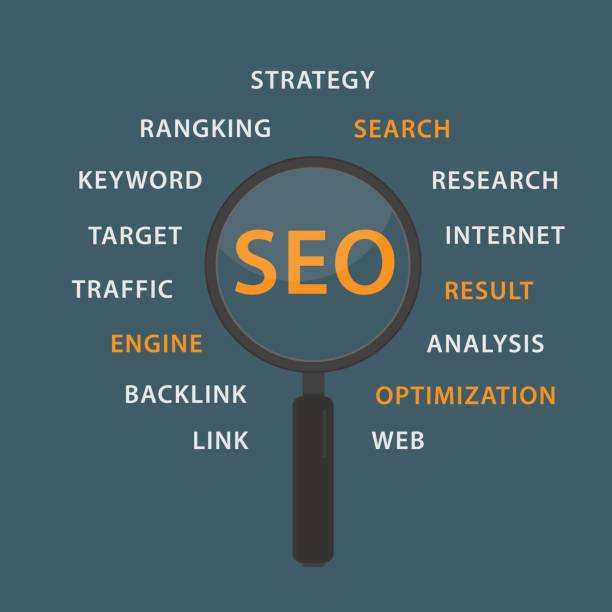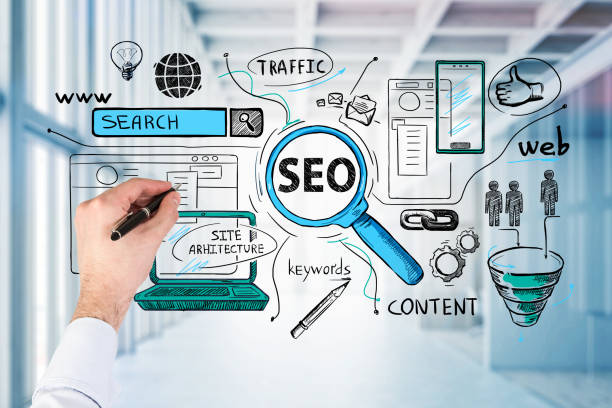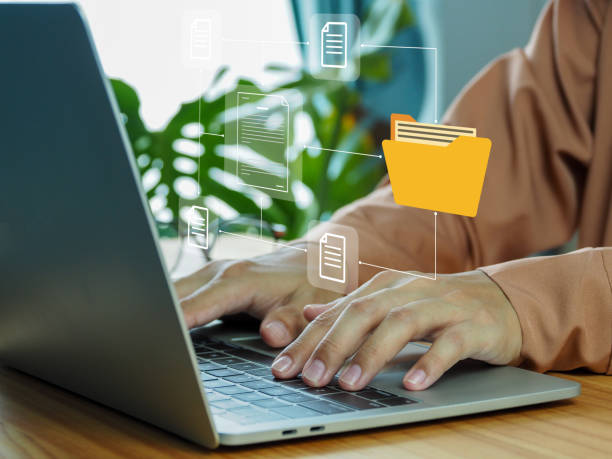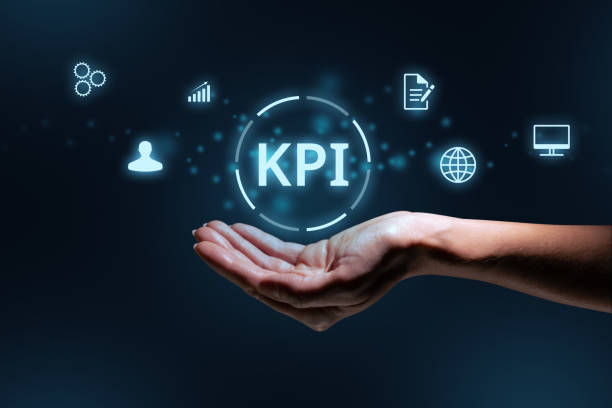What is On-Page SEO and Why Does It Matter?
On-Page SEO refers to a set of actions you take within your website to improve your site’s ranking in search engines like Google. These actions include optimizing content, site structure, HTML tags, and other technical factors.
The definition of SEO is only the beginning; understanding its importance is key.
The importance of #On_Page_SEO stems from the fact that it helps search engines better understand your site’s content and display it to relevant users. The more optimized your site is for search engines, the more likely it is to rank higher in search results.
A site with strong on-page SEO provides a better user experience, resulting in a lower bounce rate and more time spent on the site by users.
In general, SEO benefits include increased organic traffic, improved conversion rates, and increased brand credibility.
Search engines like Google help a lot in this area.
To better understand #On_Page_SEO, imagine your site is a physical store.
If your store is organized and tidy, products are properly arranged, and there are clear labels, customers can more easily find the products they are looking for and are more likely to make a purchase.
On-page SEO does exactly the same thing for search engines.
Are you tired of missing out on business opportunities due to not having a professional corporate website?
Rasweb helps you by designing a professional corporate website to:
✅ Build a powerful and reliable image of your brand
✅ Turn website visitors into loyal customers
⚡ Get a free consultation right now!
Keyword Research, the Cornerstone of On-Page SEO
Keyword research is the first and most important step in #On_Page_SEO. Before you start producing content or optimizing your site, you need to know what words users are searching for in search engines to find the information they need.
These keywords should be relevant to your business and have a good search volume.
Click here to preview your posts with PRO themes ››
To do keyword research, you can use various tools such as Google Keyword Planner, Ahrefs, and Semrush.
These tools help you find keywords related to your business, check their search volume, and assess the level of competition for them.
After finding the right keywords, you should use them naturally and relevantly in your site’s content.
Overusing keywords (Keyword Stuffing) not only does not help improve your site’s ranking, but may also cause your site to be penalized by Google.
Keyword research tools help you choose the most optimal words for your business.
When choosing keywords, pay attention to user intent (Search Intent). For example, if a user searches for the phrase “buy laptop,” they are most likely looking to buy a laptop.
In this case, you should produce content that meets this user need, such as a shop page that offers a variety of laptops with full prices and specifications.
By understanding user intent, you can produce more relevant and engaging content that increases the likelihood of clicks and conversions.
Optimizing Title Tags and Meta Descriptions
Title Tags and Meta Descriptions are two important elements in on-page SEO that are displayed in search results.
Titles tell users and search engines what your page is about.
Meta descriptions provide a summary of your page’s content and encourage users to click on your link.
Titles should be short, engaging, and contain the main keyword.
Titles should not be longer than 60 characters, otherwise they will be cut off in search results.
Meta descriptions should also be engaging, descriptive, and contain the main keyword.
Meta descriptions should not be longer than 160 characters.
Meta descriptions play an important role in attracting users.
Each page of your site should have its own unique title and meta description.
Using duplicate titles and meta descriptions can damage your site’s ranking.
When writing titles and meta descriptions, try to be creative and use words that grab users’ attention.
You can also use a Call to Action such as “Buy Now” or “Read More” in the meta description to encourage users to click.
| Element | Description | Best Practice |
|---|---|---|
| Title Tag | The title of the page that is displayed in search results. | Contains the main keyword, short and engaging, maximum 60 characters |
| Meta Description | A summary of the page’s content to encourage clicks. | Engaging, descriptive, contains the main keyword, maximum 160 characters |
| Keywords | Words that users use to search. | Relevant to the content, appropriate search volume, natural and relevant use |
Optimizing URL Structure
Your site’s URL structure should be logical, readable, and contain keywords.
Short and descriptive URLs help users and search engines better understand your page’s content.
Avoid using long and complex URLs that include meaningless numbers and letters.
For example, instead of using a URL like “example.com/page?id=123”, use a URL like “example.com/blog/seo-internal”.
The second URL is clearer and more relevant, and helps search engines better identify the topic of your page.
Also, try to use the main keywords in your URL, but avoid overusing keywords.
Optimized URL structure is vital for SEO.
Use hyphens (-) to separate words in the URL.
Using underscores (_) or other characters may cause problems for search engines.
Also, try to keep your site’s URL as short as possible.
Long URLs may be cut off in search results, which will reduce the click-through rate.
Is your online store ready to attract maximum customers and increase sales? Rasweb transforms your online business with modern and efficient online store designs.
✅ Increase speed and improve SEO
✅ Excellent user experience on mobile and desktop⚡ Get a free online store design consultation from Rasweb!
Optimizing Content for Search Engines and Users
Content is king! High-quality and relevant content is the most important factor in on-page SEO.
Your content should be valuable, useful, and engaging to attract users and keep them on your site for longer.
Also, your content should answer users’ questions and needs and help them achieve their goals.
Content optimization should be done for both search engines and users.
Before you start writing content, do your research and see what words users are searching for in search engines to find the information they need.
Then, use the main keywords in your titles, subtitles, body text, and images naturally and relevantly.
Avoid repeating keywords too often, as this may cause your site to be penalized by Google.
Content is king, this motto should always be in your mind.
Organize your content in a way that makes it easy to read.
Use headings, subheadings, paragraphs, and lists to divide content.
Use images, videos, and other visual elements to make the content more engaging.
Also, make sure your content is grammatically and spellingly correct.
Grammatical and spelling errors can damage the credibility of your site.
Optimizing Images and Videos
Images and videos play an important role in making content more engaging and improving the user experience.
But if images and videos are not properly optimized, they can slow down the site’s loading speed and damage the site’s SEO.
Therefore, optimizing images and videos for on-page SEO is very important.
Image optimization can have a big impact on site speed.
To optimize images, use appropriate formats such as JPEG and PNG.
JPEG format is suitable for images with many colors, and PNG format is suitable for images with few colors and text.
Reduce the size of images to increase site loading speed.
Use image compression tools to reduce image size.
Choose a descriptive name for image files and use relevant keywords in the file name.
Write Alt Text for your images.
Alt text helps search engines understand the content of the image.
Also, alt text is displayed to users if the image does not load.
To optimize videos, upload videos to video platforms such as YouTube and Vimeo.
These platforms help you easily place videos on your site and attract more traffic to your site.
Optimize video titles, descriptions, and tags, and use relevant keywords in them.
Embed videos on your site and use Schema to mark up videos.
Schema helps search engines learn more about videos.
Optimizing Internal and External Links
Internal and external links play an important role in site SEO.
Internal links help users and search engines navigate your site and find related pages.
External links to other sites show that your site is credible and trustworthy.
Internal links help improve site ranking.
To optimize internal links, link related pages to each other.
Use descriptive and relevant anchor text.
Anchor text should tell users and search engines what the linked page is about.
Avoid linking to irrelevant pages.
Avoid linking to low-ranking pages.
Limit the number of internal links on each page.
Too much linking can confuse users and search engines.
External links are also important, but should be chosen carefully.
To optimize external links, link to credible and relevant sites.
Avoid linking to spam and untrustworthy sites.
Use the Nofollow attribute for external links that you do not trust.
The Nofollow attribute tells search engines not to follow this link.
Limit the number of external links on each page.
Too much linking can reduce the credibility of your site.
Improve your site’s on-page SEO by using internal and external links
| Link Type | Description | Best Practice |
|---|---|---|
| Internal Link | Links to other pages on the same website. | Related pages, descriptive link text, limit the number of links |
| External Link | Links to pages on other websites. | Credible and relevant sites, use nofollow if needed, limit the number of links |
Improving Site Loading Speed
Site loading speed is an important factor in SEO and user experience.
Users who have to wait a long time for a page to load are likely to leave your site and go to another site.
Also, Google gives a better ranking to sites that have a faster loading speed.
Site loading speed is an important factor in ranking.
To improve site loading speed, use a quality hosting.
Optimize images and videos.
Use an optimized Content Management System (CMS).
Use a Cache plugin.
Optimize your site’s code.
Use a Content Delivery Network (CDN).
Reduce the number of HTTP requests.
Use Gzip compression.
Increase site speed with proper on-page SEO.
To check your site’s loading speed, you can use various tools such as Google PageSpeed Insights, GTmetrix, and Pingdom.
These tools help you identify your site’s loading speed problems and find solutions to fix them.
By fixing the site’s loading speed problems, you can improve the user experience and increase your site’s ranking in search engines.
Did you know that 94% of the first impression of a company is related to its website design?
Rasweb helps you make the best first impression by providing professional corporate website design services.
✅ Create a professional and trustworthy image of your brand
✅ Easier attraction of potential customers and improvement of online position
⚡ Get a free corporate website design consultation
Optimizing for Mobile
Today, more users access the Internet through mobile devices.
Therefore, optimizing the site for mobile is very important.
Your site should be displayed correctly on mobile devices and provide a good user experience for mobile users.
Optimizing for mobile is especially important.
To optimize the site for mobile, use Responsive Design.
Responsive design allows your site to automatically adapt to the screen size of different devices.
Use a suitable font for mobile.
The font size should be large enough for mobile users to easily read the text.
Make the buttons and links large enough for mobile users to easily click on them.
Use images and videos optimized for mobile.
Improve the site loading speed on mobile.
Optimize the site for mobile with proper on-page SEO.
To check whether your site is optimized for mobile or not, you can use Google’s Mobile-Friendly Test tool.
This tool helps you identify your site’s mobile optimization problems and find solutions to fix them.
By optimizing your site for mobile, you can improve the user experience and increase your site’s traffic.On-page SEO can help you.
Monitoring and Measuring On-Page SEO Results
On-Page SEO is an ongoing process and you should constantly monitor and measure the SEO results of your site.
By monitoring and measuring results, you can figure out what actions are effective and what actions need improvement.
SEO analysis is essential to understanding site performance.
To monitor and measure on-page SEO results, you can use various tools such as Google Analytics and Google Search Console.
These tools help you check your site’s traffic, check your site’s ranking in search engines, check the keywords that users reach your site with, and identify your site’s errors.
By analyzing the data obtained from these tools, you can improve your SEO strategy and achieve better results.
With the help of on-page SEO, we can optimize our site.
For example, check which pages of your site have the most traffic.
Check which keywords drive the most traffic to your site.
Check what your site’s Bounce Rate is.
Check how long users stay on your site.
By analyzing this data, you can figure out which pages and keywords need to be optimized.
On-page SEO helps you get the best results
FAQ
| Question | Answer |
|---|---|
| What is On-Page SEO? | It refers to a set of actions that are performed within the website to improve the ranking in search engines. |
| Why is On-Page SEO important? | Because it helps search engines better understand the content and structure of your site and improves the user experience. |
| What are the most important elements of On-Page SEO? | Title and meta descriptions, keywords, URL structure, high-quality content, image optimization, internal linking, and site speed. |
| How do we optimize the Title Tag and Meta Description? | The title should include the main keyword and be engaging, and the meta description should be an encouraging summary of the content with relevant keywords. |
| What is the role of keywords in On-Page SEO? | Keywords make search engines understand what the page content is about and should be used naturally and intelligently in the text. |
| How is image optimization done for On-Page SEO? | By compressing the volume, using a descriptive file name, and filling the Alt tag with relevant descriptions and keywords. |
| What is Internal Linking and what is its application? | It is the connection of different pages of the site to each other. This helps to distribute the authority of pages (Page Authority) and improve the crawling of search engines. |
| What is the importance of site loading speed in On-Page SEO? | High speed improves user experience and is one of the important ranking factors for search engines like Google. |
| How does the responsiveness (Mobile-Friendliness) of the site affect On-Page SEO? | Given the increase in mobile users, being responsive is essential to provide a suitable user experience on all devices and Google’s mobile-first indexing priority. |
| What are the important factors related to content in On-Page SEO? | Originality, quality, comprehensiveness, readability, proper use of headings (H1, H2,…), and regular content updates. |
And other services of Rasa Web Advertising Agency in the field of advertising
Intelligent Content Strategy: An innovative service to increase SEO ranking through marketing automation.
Intelligent SEO: Transform sales growth with the help of real data.
Intelligent Sales Automation: A professional solution for digital branding with a focus on intelligent data analysis.
Intelligent Brand Identity: An effective tool for user interaction through intelligent data analysis.
Intelligent UI/UX: Professional optimization for customer attraction by customizing the user experience.
And more than hundreds of other services in the field of internet advertising, advertising consulting and organizational solutions
Internet Advertising | Advertising Strategy | Advertorial Report
Resources
Comprehensive Guide to On-Page SEO – Maziar Panahi
,What is On-Page SEO? Step-by-step On-Page SEO Training | Raya Marketing
,On-Page SEO Checklist for Ranking on Google in 2024
,What is On-Page SEO? Step-by-step On-Page SEO Training | Nars
? With Rasweb Afarin, transform your business in the digital world! By providing comprehensive digital marketing services, including Corporate Website Design, SEO and social media management, we pave the way for your online success. Shine with us and reach the peaks of your business.
📍 Tehran, Mirdamad Street, next to the Central Bank, Southern Kazerun Alley, Ramin Alley No. 6














